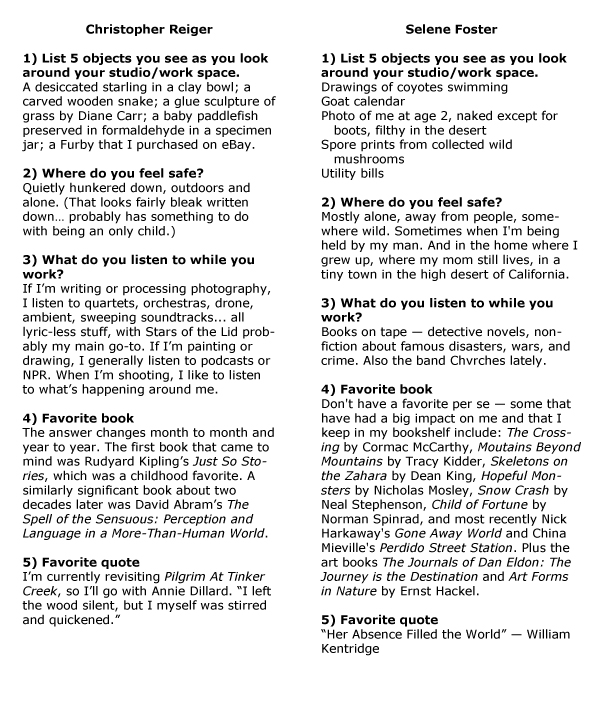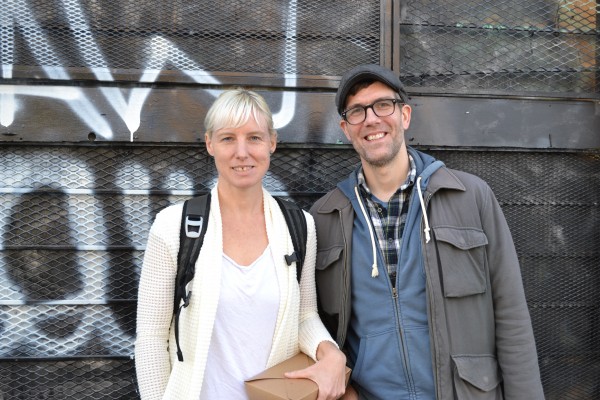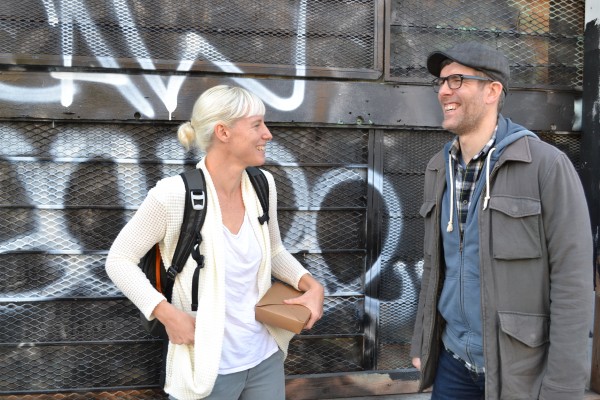The Edge Effect
unexpected projects is a collaboration between Jenny Salomon and Jen Stager. In this series, they interview other collaborative teams in the Bay Area to find out what their projects and processes are all about.
In Conversation: Selene Foster and Christopher Reiger of BAASICS: Bay Area Art and Science Interdisciplinary Collaborative Sessions
We met with Selene Foster and Christopher Reiger at Gracias Madre to talk about their collaboration through BAASICS, the nonprofit they founded together as a means of exploring contemporary topics through the juxtaposition of art and science. Their collaboration began when they co-curated A Live Animal, an exhibition at Root Division in July 2011. We introduced the subject of collaboration and the pair jumped right in with some striking thoughts: when working with someone else you think bigger, you work off of each other’s momentum, work off of each other’s strengths. You don’t feel alone. You are a little more brave.
unexpected projects: What are the themes you guys have addressed so far in your events?
Christopher Reiger: The first event was in conjunction with the exhibition A Live Animal, so human and nonhuman animal relationships. The second was very broad called The Future, and it was about the 1950s idea of utopia-dystopia, what is just around the corner, things like robots and curing aging.
Selene Foster: Then the third was The Deep End, which focused on the connection between creativity and mental illness or mental differences. And the fourth one was Watershed, which talked mainly about our particular watershed. It was just around the time when, incidentally, the State of California declared an emergency in terms of the drought. And the fifth one was Monsters. For that one we broke out of our typical one-event structure and treated it as a longer process, and actually did two big events.
CR: Watershed was very exciting and to me one of the things I am most thrilled about is that we stumbled into commissioning — as much as we can with our small budget .The composer Karl Cronin wrote an original piece [“we were once, you and I, the same water”] that was performed with a quartet during the event; he went to Hetch Hetchy, walked around, and wrote a composition about Hetch Hetchy water coming to him in San Francisco.
SF: Music has a way of opening up people emotionally. We’ve found that having something at the beginning of a program, whether it is music or one of us speaking or whatever it is really puts the audience in a mode of taking in and feeling the theme as opposed to just thinking about it. Music is a great vehicle for that, or someone sharing a personal story.
CR: I think the best example of that was The Deep End program, which opened with Hannah Addario-Berry, who is a cellist, performing the first movement of a two movement piece by a Hungarian composer named György Ligeti. The story behind the piece is that he wrote the first movement as a gift for a woman with whom he was in love; she rejected his overture, both his love and the music, so he shelved it. Years later, he wrote a second movement in response to the first movement, which is this frenzied, intense, angry, emotive piece. So Hannah Addario-Berry opened the program performing the first movement. And then Selene gave a very personal introduction to the program, talking about her own experiences and interests in the subject matter (mental illness), which really personalized it. After intermission, Hannah played the second movement — but before she did, she explained the background of the music. She also talked about her dad, who had bipolar disorder, and described this particular piece of music as the best aural summation of what it is to be bipolar.
SF: That right brain activity [was] coupled with a data-driven presentation by a neurobiologist, Terence Ketter, from Stanford who works with bipolar people. I felt like there was a communion there.
CR: When you think about accessibility, there may be some person in the audience who is really responding to Selene’s opening introduction and Hannah performing music, but then someone else would respond more to Terence Ketter presenting data on bipolar disorder. The idea behind BAASICS is to juxtapose art and science, both of which are inaccessible to most Americans. Art is either this academic ivory tower world or a luxury market, both of which are very removed from most of the population. Science has always been this cloistered activity, and now much of the US can be hostile towards science. That distance exists because art and science feel alien. So how do you make these things less alien? I like the idea that some people in the audience might be more scientifically oriented, but find themselves opening to the art through the science, and they both become more accessible. Or vice versa.
UP: What are the strengths that you bring to the collaboration and what are the strengths of your partner?
SF: Christopher is more methodical, I’m a bit more impulsive. He’s very detail-oriented and I tend to be more big-picture.
CR: In agreement with that, when I think about Selene’s strengths, I get really excited when I’ve written something and sent it to Selene and she sends her edits back and I read them and think “this is so much better!” She might take an idea which I’ve treated in this very inhumane, hyper-rational way and gives it a lot of humanity and emotion and connection.
UP: That makes it more accessible to your audience. Together you create different entry points.
SF: Christopher is incredibly responsive with his communications; it is such a rarity in this particular world. I never have any fear that you, Christopher, are not going to be there when you need to be or I need you to be. You are also really good at pushing things forward. Something that would take me six months to accomplish we get done in two because Christopher is always pushing it forward and remembering the small things and sending the emails.
CR: And harassing people! All these things can be framed in a positive way but they can also be summed up as: “that guy is such a prick!”
SF: Whereas I have weeks when I do not want to open my computer, so if it weren’t for that dual component, BAASICS just wouldn’t work.
UP: But maybe during those times when your computer is closed, you’re exploring something that comes back into the collaboration.
SF: I tend to need to think about things for a lot longer.
CR: Often when you’ve traveled you come back with new energy and ideas, because you’ve been able to step away and process it.
SF: If Christopher didn’t have some sense of who I am as a person and sometimes my need to just say “I’m leaving,” it would be really difficult to work together because I would be afraid to talk to him and tell him what is really going on.
CR: This sounds dramatic but it is a relationship, it is a partnership, in the same way as, ideally, your life partner is. It doesn’t always work this way but sometimes I find if things are really good, if I fall into a bad place, a mild depression or if I am in a funk creatively, Elizabeth, my wife, will pick me up again. When she gets sick and grumpy and angry at the world, I become Mr. Sunshine. That is not my personality but I turn it on to keep the balance. And it seems natural; it’s never a conscious thing. In a collaborative relationship, the same thing happens in a different manifestation. I feel like even though Selene and I do discuss things going on in our personal lives and try to be there for each other on that level, also on a purely creative mode, when one of us is operating more in X capacity, the other goes more for Y to help spread it out.
UP: Also, in an intimate relationship as well as in a creative collaboration, which is intimate in a different way, you are trusting that the other person can take what you are going to say, and you can actually hear each other.
SF: And it’s fun watching that evolve. I don’t know if fun is the right word, but in the beginning we were super careful with each other and as it goes on you become less and less so but it is still important to be careful. I don’t want to be blasé about our partnership because Christopher is another human being. In that sense collaboration is also similar to [an intimate] relationship. You get so normalized with your partner and then you realize they still need you to put in extra effort.
CR: At the start, we definitely worried about how the other person would take constructive criticism or just frank disagreement. What I’ve gotten to through collaboration is to trust that if someone says something critical from which I naturally recoil, I can take a breath and think about it for however long it takes. Now, it doesn’t take me as long because I have had so much practice.
UP: How has collaborating together fed back into your individual practicing? Or is BAASICS your main practice?
SF: For me BAASICS has been the main practice. Only recently have I felt that I need to start drawing again. To the credit of our project, for the run of it, I have been quite absent from my other practice and fulfilled by this. Life is like that. There are probably cycles that I can’t identify. I know for sure that when I do start drawing again, that everything we have done together will feed into my drawing. So in that sense it is okay. It is actually kind of hard to say that out loud, that I haven’t made a drawing in months, because there are certain expectations that if you’re an artist, this is the product. I still struggle with those expectations even in the midst of this very wide-ranging practice.
UP: Those lines don’t have to be so rigid. You are making something; you are making a community. You are developing something; you are engaging in a creative way with several people. It is not a drawing, but you’ve created something else.
SF: Yeah, we’ve been able to connect with and learn from so many creative artists and scientists in this area that it has been a massive education that is going to take a long time to process.
CR: And I think too, curating A Live Animal, the show that preceded BAASICS, was a creative awakening. This is a creative arm of my practice, which I never knew could exist. I lost all interest in painting and drawing. It was still there in the back of my mind, but I didn’t miss it. Once I accepted that I was totally fine with BAASICS as my creative avenue. And then six months ago I started spending some time in the studio. I’ve started getting into photography — in fact, the BAASICS collaboration has introduced other modes of my own visual practice, which are now becoming something different on the side.
UP: What is the theme for your next event?
CR: Borderlands is our next event and the overarching theme is very broad. Borderlands can be something very literal like ecological habitats meeting, or gentrification, [or] philosophical concepts like blood–brain barrier, which has a physical manifestation but also dictates the body/mind separation. The next program we have lined up is a sub-theme of that bigger theme, with American Association for the Advancement of Sciences [who] publish the journal Science. The theme of their meeting is the “human epoch”, or the idea that humans are in a geological epoch. In Borderlands we are dealing with how the human landscape meets the nonhuman landscape. The title we will use for the subsidiary event at the AAAS meeting is “The Edge Effect”, which is a catchy name but is also an ecological term for the transition that happens when any two habitats change, particularly human and nonhuman.
SF: When we were talking with our advisory board about this particular idea for a theme, they said, “well that’s what BAASICS is, the coming together of art and science.” Typically we don’t like to shove them together, but instead to see what happens when [art and science] are next to each other. This is a similar principal to collaboration in general—when two separate people come together to make something work. 

